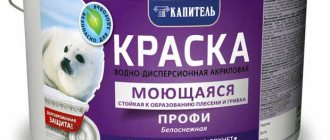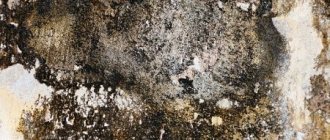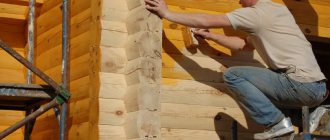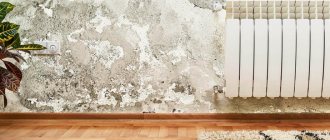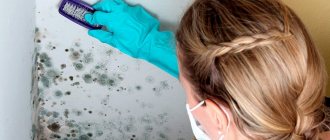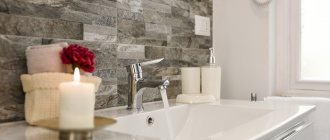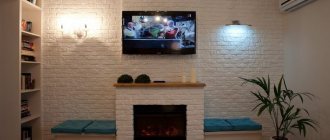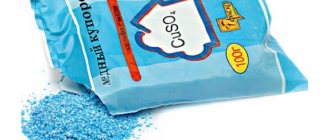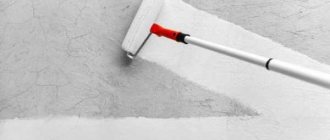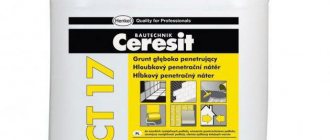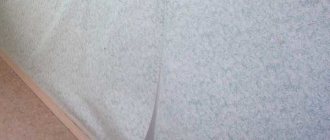Protecting the surfaces of residential premises from mold is a mandatory condition for their finishing and operation; failure to do this stage is literally dangerous for the health and condition of building structures. A primer against fungus and mold is used in the construction and decoration of wooden structures, the preparation of any type of base before finishing, the need to clean surfaces from developed colonies of pathogenic microorganisms and a number of other tasks. With the right approach, its composition, purpose, method of application and other performance characteristics are taken into account along with the type of surfaces being treated and their operating conditions.
How to apply primer correctly
In order for the protection to be as effective as possible, the application rules must be followed. The technique differs for different types of compositions, but there is a general algorithm that should be followed.
Surface preparation
The preparatory stage is important, especially when working with a contaminated surface. First of all, you will need to remove the mold using a rag soaked in white. The rag must be burned to stop the spores from spreading. The treated surface should be dried. Then the damaged plastered area is removed. Use a burner to dry and disinfect the surface. Next, carbon deposits and dust are removed, after which an antifungal primer is applied.
Application methods
Important! When covering walls with soil, do not neglect the protection rules. Use personal protective equipment: full-body clothing, gloves, respirator, goggles
Reasons for appearance
First, let's understand the concepts. Mold is a fungus that comes in several varieties. It develops by airborne spores. This is how we see it with our eyes:
Conventionally (for the average person) they can be divided into useful and dangerous. Useful ones are used for the production of food products (certain types of cheese, wine, citric acid, etc.), medicines (penicillin, etc.). Dangerous... it would take too long to list them.
The main reasons for the ripening of fungal mold are humidity above 60% and insufficient ventilation. The reason for this can be different:
- - walls with poor vapor permeability;
- — errors in repairs;
- — leaking plumbing;
- — wrong decisions at the construction stage.
It would take a long time to list, but the main thing has been mentioned.
And this is under a microscope. Fantastic! Space! Aliens!
When antifungal treatment is carried out: conditions
Due to the great danger of the development of fungal colonies in the premises, treatment is carried out immediately:
- If visible signs of damage are detected - the appearance of plaque, mucus, and blackening of the surface.
- After eliminating emergency situations involving water flooding or sewerage breaks.
- When there is a systematic deterioration in the well-being of people in the room.
Preventive treatment is carried out:
- During the renovation of the premises.
- During general cleaning.
- Before and after the end of the heating season.
To increase the effect of using fungicides and disinfectants against mold, it is recommended to additionally treat the walls of the bathroom and toilet at least once a week.
Work order
The primer can be applied with a roller, spray or brush. The first tool is used to process a small area, the second is suitable for large surfaces, and the third is used to penetrate hard-to-reach places.
Processing stages:
- distribution of primer over the surface;
- applying a second layer (if necessary and only after the previous one has dried);
- finishing.
The primer is selected taking into account the type of surface. When processing, for example, walls, a composition intended exclusively for this purpose is used.
Antifungal primers are indispensable assistants in the fight against mold. To avoid the appearance of fungal colonies, you should regularly treat with the means described above.
Treatment with antifungal primer, instructions for use
Materials are applied directly to areas that are subject to infection. But you don’t need to apply the substance specifically to the stains. It is recommended to rinse the surface in advance to clean it. To do this, use chlorine, and then resort to further processing.
Materials are applied directly to areas that are subject to infection.
Surface preparation and additional tips
The effect of primers increases over time if you take care of pre-treatment of the walls. After weathering and drying, it is allowed to use soldering irons or hair dryers so that the processing produces results.
Other recommendations from experts are as follows:
- Cleaning and pre-drying the walls is mandatory, as already mentioned;
- Mold can simply be cleaned with “white” diluted with water. But you shouldn’t completely calm down, even if the spots are no longer visible. Cleaning with a hair dryer or blowtorch is faster. But it is better not to use this method under wallpaper;
- Be sure to ventilate the premises. Convectors or fans do this job inside bathrooms. Under other circumstances, windows are opened wide, creating drafts;
- You cannot use a regular primer before using an antifungal primer. After all, other materials form protective films that prevent the penetration of not only harmful microorganisms, but also beneficial substances;
- Maintaining dryness in the premises, warm weather - optimal conditions for work;
- Aerosols, brushes and rollers help the master best. Especially if you have bristles with natural fibers. Thanks to this method, the composition is applied even in hard-to-reach places.
- Compliance with safety measures is mandatory during operation. Even if wood is being processed.
Keeping the premises dry and warm are optimal working conditions.
Work order
Distributing the composition over the surface, take rollers or brushes, sprayers. The roller is combined with small areas. The brush complicates repair work, but allows you to easily reach hard-to-reach places. A sprayer is used if the treatment area is really large.
Several stages are included in antifungal treatment:
- Apply a layer of antifungal primer for walls.
- Wait a while for everything to dry.
- If necessary, apply a second layer.
- Finishing after complete drying.
Maintaining a positive ambient temperature is the main condition for successful work. Negative factors remain the same when finishing inside and outside. When using antifungal agents, protection against harmful microorganisms is simplified. The choice of which type of antifungal primer to use in a particular case is determined by the type and condition of the surface.
The brush complicates repair work, but allows you to easily reach hard-to-reach places.
Primer consumption per 1 m2
The quality, characteristics and types of materials for processing affect what the material consumption will be. An important role is played by the temperature and humidity that remain in the room. The rate increases if the mold primer requires at least two coats rather than one.
Consumption rates are indicated by the manufacturer on the packaging. But experts recommend multiplying standard odds by at least 1.5. Then it will be easier to anticipate some situations.
Most universal compounds are suitable for working with concrete surfaces. Manufacturers provide recommendations regarding places of use and operating conditions. You need to familiarize yourself with them before purchasing, only in this case the anti-fungal composition will be effective.
Most universal compounds are suitable for working with concrete surfaces.
When using any primer, be sure to follow safety precautions and protect yourself. Instructions and work tips are also read before the project begins to be implemented. Everyone needs a respirator and safety glasses. The primer itself is stored in places where children cannot reach it. You should not immediately follow the advice about buying compounds with a reserve. It will not be difficult to purchase additional materials. But it is difficult to use the excess - there is a high probability that the expiration date will expire earlier. This also prevents unnecessary spending.
Working with antifungal primer
In order to prevent the formation of mold and get rid of it, an integrated approach is required.
This is the only way to ensure complete elimination of fungal spores and completely destroy the lesion:
- Eliminating the causes of excess moisture in the room. It is imperative to find the source of mold and correct any violations in the joints of walls, slabs or pipes. If this is not done efficiently, the fungus will return and you will have to start the whole range of measures all over again.
- Setting up the effective functioning of the ventilation system. It is necessary to ensure the correct installation of window slopes and take care of regular ventilation of the room.
- Using a solution of water and detergent (for example, bleach), use a rag to wash off black fungal stains from the surface of the walls or ceiling, after which you must throw away the rag, or better yet
- burn. This procedure is necessary to prevent fungal spores from spreading throughout the room during further stages of work.
- Dry the washed surface well using heating devices or strong drafts.
- Completely remove the contaminated area of plaster.
- Use a blowtorch or gas burner to treat the surface area freed from plaster to dry and disinfect it.
- Clean the treated surface from carbon deposits and dust.
- Apply a special antifungal primer to the surface.
- After four hours, the surface can undergo a new finish (plastering, covering with wallpaper, paint or tiles).
To apply the primer solution to small areas, use a paint brush, to larger areas, use a roller, and to large surfaces, use a spray bottle. The primer layer should be even, without gaps. For the best effect, the primer is applied more than once at the rate of ½ liter of composition per 1 square meter. It is correct to apply layers of primer or antibacterial paint perpendicular to one another to avoid bald spots. Rubbing movements when applying antifungal agents will ensure deeper penetration of the composition into the surface being treated.
In addition to working inside the building, it is also necessary to inspect its outside. A struggle waged from the outside and from the inside at the same time will be more productive.
An important rule is to follow safety precautions when working with fungus. Mold is dangerous to health, so when working to get rid of it it is necessary to use personal protective equipment: rubber gloves, close-fitting goggles, a respirator, a hat, and thick clothing.
Another immutable rule when you discover a fungus and want to get rid of it is not to use a primer that does not have antifungal properties. This primer creates a film on the affected surface, under which mold feels at ease and multiplies even more actively, penetrating deeper.
In order to avoid a complex of problems associated with the formation of black spots in the future, it is advisable to ensure that there are no sources of constant moisture even at the construction stage. To do this, you will need to organize waterproofing according to all the rules.
A house that is not equipped with drainage trenches on the outside to drain precipitation and groundwater is at risk. A foundation treated with a leveling base with an antifungal compound along the upper end or in its entirety is the key to good waterproofing.
In terms of its cost, primer against mold and mildew differs greatly from simple formulations. However, the use of such a primer is much less expensive compared to measures to get rid of mold stains. Therefore, saving on mold primer is not advisable.
In addition to antiseptic and antifungal properties, primers have a protective effect on walls. Rodents, larvae and other parasites will not destroy surfaces coated with special compounds. Such treatment is relevant for wooden surfaces, since this material is subject to rapid destruction in unfavorable conditions.
Traditional methods
In addition to factory-quality primers, the following can be used to remove and prevent mold and mildew:
- Solutions of any chlorine-containing bleach mixed with water in a ratio of 1:10, applied to walls or floors without the need for rinsing. The advantages of this product include high efficiency (bleach kills almost all types of pathogenic microorganisms and prevents their reappearance), the disadvantages are causticity and risks of damage to surfaces.
Bleach solution - A 3% solution of hydrogen peroxide, which has properties similar to bleach (high efficiency + bleaching), but requires rinsing. This product is sprayed, left on surfaces for 5-10 minutes, no more, and washed off with water along with mold residues.
Hydrogen peroxide - Vinegar sprayed onto affected surfaces for 1 hour, washed off with lukewarm water.
Vinegar - Ammonia, mixed with water in equal doses, applied using a spray bottle or a cotton swab. Due to rapid evaporation, the maximum effect of its use is achieved when treating hard surfaces, including bathroom tiles, and the minimum effect is achieved when working with porous substrates.
- A highly effective inhibitor of mold development is borax, mixed with water (1 tbsp per 2.5 l), applied to surfaces with hard brushes without rinsing. In case of a high degree of damage, the walls or floor are treated with the resulting mixture many times.
Borax - Aqueous solutions of ammonia in a 1:1 ratio, sprayed and removed with clean water along with mold residues. This substance is classified as toxic and, if possible, should not be mixed with other components.
Ammonia solutions - Baking soda mixed with water in a small proportion (1 teaspoon per 1 liter of water), sprayed over the surface and removed after 1 hour. The same composition is considered optimal when it is necessary to remove the stale smell of fungus.
Baking soda - Essential oils (tea tree, lavender, rosemary, citrus seed extracts), mixed with water in a small amount (10 drops or 1 teaspoon per 1 cup of water), sprayed without rinsing. Basically, such products are recommended to be used as preventatives; the longer they remain on the walls, the better the protection will be.
Essential oils - Weak (1 teaspoon per 1 liter of water) solutions of potassium permanganate, applied by analogy without the need for rinsing.
Weak solution of potassium permanganate - Citric acid or drops of lemon juice (1 teaspoon per 1 cup of water). Such concentrates are suitable for washing joints and tiled surfaces.
Lemon acid - Other, self-prepared mixtures. An example is the ratio of water, peroxide, vinegar, boric acid 4:2:2:1, an aqueous solution of copper sulfate (0.5 kg per 10 l) with 2 tablespoons of acetic acid, wash-off mixtures of bleach, liquid soap, baking soda and essential oils.
It is worth noting that almost all highly effective folk remedies, including chlorine, ammonia, hydrogen peroxide, organic acid concentrates and borax, are hazardous to health. Due to the risk of forming toxic fumes, they cannot be mixed with each other (which is especially true in relation to chlorine and ammonia). In any case, work on the preparation and use of solutions is carried out with gloves; a test portion is made small and applied to inconspicuous areas.
Antifungal primer - purpose, properties and application
Manufacturers offer a wide range of anti-fungal products, but each product has its own parameters. Please note that only professional options are designed for deep sanitation of surfaces and complete removal of mold. The bulk of proposals provide only effective prevention. Antifungal primer for walls is usually applied after the damaged plaster has been completely removed from the load-bearing surface of the building. This is done with the aim of creating a barrier between the masonry and a new layer of plaster - preferably cement-lime.
Building mixtures are usually not designed for reuse. Only clay damaged by fungus can be used repeatedly, provided that a solution made with the addition of lime is applied. Lime and clay help get rid of the problem. If plaster is applied to the wooden base of an adobe, frame or timber house, it is recommended to pre-paint the surfaces with a self-prepared sanitizing liquid based on copper sulfate.
Manufacturers offer many different anti-fungal mixtures
All antifungal agents contain fungicides and a base that creates a barrier (acrylic, mineral, alkyd, latex, etc.). For effectiveness, a disinfectant composition is used, providing both antibacterial and antiseptic protection. The difference between antiseptics and fungicides is that the former provide short-term sanitation, the latter – long-term. The anti-mold properties of a liquid coating depend on the amount of certain substances that act against fungus and their penetrating ability.
Depending on the purposes and substances used to prepare the antifungal primer, the purpose, properties and application may vary. For example, some products are used as a surface treatment for areas affected by mold, while others create a strong protection for a new coat of plaster. Depending on the base used, concrete, brick, polystyrene bases, fine-porous and large-porous materials can be processed.
Choose products based on the characteristics of the affected area
Types of antiseptics by composition
A wide range of antiseptic primer compositions allows the use of finishing materials for finishing work without restrictions. Specially developed formulations help to significantly strengthen the base, making it resistant to mechanical, chemical and biological destruction. The finishing finishing material lies evenly on the primed base, and it is used sparingly.
Acrylic based
Acrylic antiseptic primer solutions are universal in use and are suitable for processing a wide range of materials. Their difference is a high level of absorption and quick drying. Primer particles penetrate into the base to a depth of 10 mm.
It is recommended to use acrylic compounds to prepare the surface for wallpapering. This reduces the consumption of adhesive, improves the quality of the sticker and simplifies dismantling in the future.
Quartz based
A quartz-based primer consists of acrylic resins and small “sand” particles. It serves as a base coat for applying embossed finishing materials: mineral stone, fiber facade, fiber stone, uniquartz, etc. This type of primer is used on concrete, brick, and plasterboard surfaces. Quartz composition can be applied to plaster and cement. It strengthens the base, improves adhesive properties and reduces the consumption of finishing materials.
Mineral
Mineral primer is used to strengthen and hydrophobize light-colored mineral building materials: limestone, plasters, porous bases. The composition gives the surface the following properties:
- equalizes absorbency;
- forms good vapor permeability;
- significantly strengthens the structure;
- protects against negative external factors;
- increases resistance to biological destruction;
- increases resistance to ultraviolet radiation.
This product combines well with silicate paint.
Alkyd
Alkyd primers are used to treat wood and metal surfaces. The composition strengthens the structure of the base, prevents damage by fungi, putrefactive bacteria, woodworms, and mold.
Alkyd mixtures combine well with PVA, nitro-based paints, acrylic putty and alkyd-based paint products. This type of primer is unacceptable for treating surfaces that tend to crumble: gypsum, plaster, etc.
Deep penetration antiseptic primer against mold
This product is intended for impregnation of highly porous surfaces. The solution particles penetrate to a depth of 10 mm, strengthening the base, increasing its adhesion and preventing the development of harmful microorganisms. Main technical indicators:
- penetration depth – 5-10 mm;
- consumption 50-300 g/m2;
- drying time at room temperature – 1-3 hours;
- operating temperatures – 5-30 ⁰С;
- operating temperature – 40-60⁰С.
The composition of a deep penetration primer can be acrylic, silicone, alkyd, polyvinyl acetate, or epoxy. In addition, there are polystyrene, shellac, silicate, latex and water-dispersion impregnations. Each of the compositions is recommended by manufacturers for treating a specific type of surface.
Types of primers: how to choose the right composition
The primer is selected based on the objectives and compatibility with the base material. Most of the brands offered are considered universal, but there are specialized primers for the antiseptic treatment of mineral surfaces or wood. There is no clear division, but as a rule:
- When treating plastered, brick or porous mineral substrates that need strengthening, it is better to use a deep penetration primer (Bergauf Tiefgrunt, Cerecit CT17, Lakra interior primer, Acryl Grundierung, Mill kill and many others). When choosing such antiseptics, costs for finishing putty or adhesives are significantly reduced and the highest level of protection against mold is ensured.
- When protecting wooden surfaces, the primer is selected taking into account compatibility with external paint coatings (if any) and operating conditions. Preference is given to non-washable multifunctional compositions with additives of fire retardants and insecticides. The best reviews in this group are from the Neomid series, Altax Boramon C30, Dufa-Holzlasur, Pinotex Base brands.
- For concrete with low water absorption, universal compounds and primers with high adhesion are best suited. The latter can be superficial, and therefore only preventive.
Particular attention is paid to the base of the antifungal primer, which has a direct impact on the temperature range of application, penetration depth, adhesion indicators and other equally important performance characteristics. From this criterion there are:
- Acrylic primers, recognized as universal, having optimal performance in terms of price, environmental friendliness, adhesion and drying speed. The presence of acrylic resins in the composition improves adhesion to the surface significantly; these brands are used with equal success for external and internal work.
Acrylic primer - Primers based on gypsum or cement with the addition of lime or liquid glass. Mineral primers have a low price and are actively used in the preparation of concrete, brick and plasterboard surfaces for plastering or puttying.
Gypsum based primer - Alkyd primers are optimally suited for protecting wood from blue mold, swelling and rotting. Such varieties dry longer than acrylic ones (10-12 hours compared to 3-4 hours); in general, they are not intended for antiseptic treatment of plaster or plaster. But when it is necessary to impregnate wood or preventively treat low-adhesive surfaces (glass or tile), they have no equal.
Alkyd primer - Quartz primer compositions with sand additives, characterized by good adhesion quality, but most often are preventive. Such brands are selected for antiseptic treatment of painted concrete or when preparing mineral surfaces before applying decorative plasters. If necessary and provided the base matches, they can be combined with other primers.
Quartz soil
When choosing a specific brand, additional attention should be paid to:
- The purpose of the soil and the depth of its penetration. Most surface grades are preventative and are not suitable for removing fungus inside structures.
- Consumption indicators and admissibility of dissolution with water. Almost all primers are concentrates, but the proportions of their mixing and the number of layers applied should be clarified in advance.
- Soil drying time and surface treatment conditions. Almost all grades for walls, floors or floors are applied to dry surfaces using a roller or sprayer, but a number of specialized compounds are introduced directly into mortars.
- Availability of additional functions (strengthening, protection from insects or weather conditions).
Emulsions to combat mold
#1: Ceresit CT 99 – long-lasting action
Antifungal solution Ceresit CT 99 is one of the most popular drugs for combating mold, fungi, lichens and destroying microorganisms. The product is environmentally friendly and can be used for interior work and for treating structures outdoors.
Ceresit CT 99 is a deep penetration emulsion. The concentrate is suitable for mineral surfaces: brick, concrete and plaster. Not used on metal substrates
Technical characteristics of Ceresit CT 99:
- active antiseptics – organic biocides;
- does not contain heavy metals;
- no traces remain on the surface after treatment;
- the drug is vapor permeable;
- application temperature – up to +40°С, but not lower than +5°С;
- Complete drying time is 4-5 hours.
Before use, the drug must be diluted with water, maintaining a ratio of 1:2 to 1:5 - the ratio depends on the degree of damage to the wall. The solution is applied only with a brush; spraying is not permitted.
#2: ABEDIS 06 – removal of organic plaque
Antifungal Abedis 06 copes with organic plaque on walls, fights fungal mold in the bathroom, kitchen and adjacent rooms
The antifungal agent can also be used as a preventive measure against the appearance of mold - the emulsion is applied not only to the damaged area, but to the entire wall
Features of the action and use of the drug:
- after use, the risk of mold reoccurrence is reduced;
- before application, the concentrate is diluted with water in a ratio of 1:2;
- After 24 hours, the treated wall should be washed with water and dried;
- In case of severe fungal damage to the walls, it is recommended to repeat the procedure after 36 hours.
Consumers note a long-term positive effect after cleaning the surface with an antifungal composition.
#3: Dali – universal antiseptic
Dali is a universal remedy, highly effective against various biological parasites. It is actively used as a preventive treatment of walls before painting paintwork, as well as to remove emerging fungus, blue stains and mold.
Dali antifungal solution is recommended for porous substrates: brick, plaster, concrete. The product does not contain chlorine and does not change the surface characteristics of materials
Disinfection tactics and concentrate consumption depend on the purpose of treatment:
- Prevention. The surface is cleaned of dirt and covered with a layer of antiseptic at the rate of 50-100 ml/sq.m.
- Removal of biological lesions. Remove visible colonies of fungi and mold, wipe and dry the wall. Treat with Dali, using 50-250 ml/sq.m. After 6 hours, repeat the procedure.
During work, safety precautions must be observed. Use protective clothing, a respirator, safety glasses and gloves. The room should be well ventilated.
#4: Fongifluid Alpa – “treatment” and prevention
Fongifluid Alpa is a fungicidal solution that destroys the source of biodestruction of the wall and prevents re-infection.
Duration of action is about two years. After applying the concentrate, the coating retains the ability to “breathe”, so the microclimate in the room does not deteriorate.
The fungicidal composition can be applied to wood, tiles, brick, cement plaster, gypsum board and ceramic tiles. Can be used outdoors and indoors
Characteristics of Fongifluid Alpa:
- the solution is ready for use;
- drug consumption – 1 liter per 4-5 sq.m;
- The surface dries after 6 hours, the base can be painted after 6 days.
Application methods and tools
The procedure depends on the degree of mold damage to surfaces and the type of protection. During the initial treatment, the rough surfaces are cleared of debris, dried, and, if necessary, freed from loose layers and old building materials. After this, the base is completely covered with one or two layers of soil and dried well before the next stage of repair or finishing work.
If it is necessary to remove mold colonies from the surface, the scheme changes: the damaged areas are covered with specialized compounds or treated with brushes soaked in an antiseptic composition. The exact procedure and the need for flushing are indicated in the instructions, deviations from which are not allowed. After removing mold from the coatings, the bases are usually treated with a second layer of antiseptic primer.
Surface impregnation is carried out using a standard set of tools:
- Clean containers for dilution, spilling liquid primers.
Containers for diluting primer - Regular brushes with long, stiff bristles, used for working in corners, hard-to-reach areas, or removing mold.
Set of brushes - A fur, velor or foam roller, selected depending on the type of primer and used for quickly processing the main areas of residential premises. For applying primers for bathrooms, facades and similar brands of deep penetration, a fur roller with long pile is best suited (high consumption is compensated by good absorbency).
Roller - Sprayer, selected when it is necessary to treat large areas.
Spray
There are few general rules when working with these compounds: antiseptic primers are diluted taking into account the recommended proportions or simply applied to the substrate at above-zero ambient temperatures. Mandatory conditions include high-quality impregnation of the entire surface (hard-to-reach areas are treated with brushes first); the presence of dry areas is not allowed. Optimal results are achieved by repeated surface treatment with thorough drying of each layer in compliance with the conditions stated by the manufacturer.
Primer is a tool for fighting mold
The antifungal primer has a special composition developed by specialists to neutralize fungal spores and prevent their return.
It is necessary to treat surfaces in the bathhouse, swimming pool, bathroom, etc. with an antifungal composition.
The use of a primer containing fungicides destroys mold by penetrating into the thickness of the wall and filling the pores of the plaster layer. The antifungal components included in the primer to kill mold pores are called fungicides.
The material used to apply the primer determines its composition. The type of top finishing coating is also taken into account.
A specialized primer containing fungicides can have different types of bases:
- acrylic;
- alkyd;
- oil;
- mineral.
Antiseptics are used as preventive measures during repair or construction work. When combating existing fungal infections of walls, soil solutions with a higher concentration of antiseptic substances and penetrating ability are used.
How to make a choice
First of all, you need to carefully read the instructions. Please note the main points:
- Area of application of antiseptic preparations (external walls, internal premises);
- The basis of the drug (oil solutions cannot be covered with finishing);
- Time of use (treat existing colonies or prevent their appearance);
- Service life of the drug.
For technical premises, it is better to choose compositions based on organic solvents - they do not add aesthetics, but they reliably protect against relapses and remove the most complex and dangerous types of parasites.
How to treat walls in living rooms: water-based or combined antiseptics. They are non-toxic and odorless. There are products designed specifically for use in wet areas - bathrooms, swimming pools and saunas.
Danger of fungus and mold
Mold usually appears where concrete bases are exposed to moisture, steam, or strong temperature changes. In residential premises, these are bathrooms, bathrooms, kitchens, rooms where the heating is not constantly turned on, etc. It is better to treat all surfaces where there is a risk of the spread of microorganisms prophylactically, without waiting for a problem to arise.
After all, fungus and mold are very dangerous to health - they release mycotoxins, their spores spread by airborne droplets, quickly enter the respiratory organs, causing a number of health problems: chronic fatigue, decreased immunity, allergic reactions, migraines, diathesis, bronchitis, asthma, rhinitis , otitis. In cases of severe infection, even problems in the functioning of the cardiovascular system, irreversible damage to internal organs, and cancer are possible.
In addition, the spores penetrate deep into the material and the fungus quickly destroys the surface on which it appears. And literally a few months after the first dark spots appear, the finish becomes loose, peels off freely, collapses and literally burns.
Getting rid of fungus is extremely difficult - in the process of treating a surface, you must carefully follow safety rules, wash all clothes at once, use special tools and means to prevent the spread of flying invisible spores further throughout your home, and prevent them from entering the respiratory tract. It is much easier and safer to immediately treat substrates in rooms with high humidity, so as not to give the parasite a chance.
Prevention measures
Anti-fungal primer for walls is the main way to avoid the spread of mold. Additionally, it is necessary to exclude conditions that contribute to its appearance. Additional preventative measures will help protect your premises from fungus:
- Monitor the condition of water supply systems in order to eliminate the increase in humidity in a timely manner.
- During construction, comply with the requirements regarding hydro- and thermal insulation.
- Carefully seal the joints between parts of the supporting structures.
- Equip high-quality ventilation, especially in kitchens, bathrooms, verandas and other similar rooms.
- If bulky pieces of furniture are located close to the walls, you need to change the layout.
- Ventilate the room periodically.
- Install heating in the house.
- Repair the water supply system in a timely manner.
- Use anti-fungus and mold products.
Mold begins to actively spread in warm conditions if there is high humidity. If such conditions are created in a room, then measures must be taken to eliminate them.
On video: how to prevent mold from reoccurring.
Causes and signs of fungus formation
External signs of indoor mold disease are difficult to ignore:
- spots of black, gray or dark green appear on the walls, ceiling or floor;
- there is a damp smell in the room;
- the tile joints on the tiles in the bathroom become dark;
- the destruction of structures begins: wallpaper peels off, plaster crumbles, brickwork crumbles.
The causes of damage by microorganisms are in most cases similar and are associated with waterlogging of building materials indoors or outside the building:
- poor quality waterproofing of surfaces when water penetrates into structures;
- freezing of walls, which causes moisture to accumulate inside;
- poorly executed insulation of joints between wall panels;
- roof leaks or cold attic;
- wooden floors of the first floor of the building, when there is a soil base under the covering;
- poor ventilation in rooms with high humidity (bathrooms, saunas, swimming pools).
Emulsions
The following compositions are most widespread today:
- Ceresit CT 99: differs in the duration of exposure. This composition is environmentally friendly and suitable for processing both inside and outside buildings. Can be used on concrete and brick.
- ABEDIS 06: used to remove organic plaque. This type of preparation is applied to brick walls, surfaces covered with plaster or ceramic tiles. Used for preventive purposes.
- Dali is a universal primer against mold and mildew on walls, with antiseptic properties. Can be used for preventive purposes before painting surfaces. Apply to concrete and brick bases.
- Fongifluid Alpa - used both to eliminate lesions and for preventive purposes. The product is suitable for treating brick and wood surfaces, ceramic tiles, drywall, cement and plaster. This concentrate provides air access to the material, which has a beneficial effect on the overall microclimate in the room.
These special products allow you to eliminate fungal outbreaks. The most popular are the following:
- Ceresit CT 99 - has a long-lasting effect. An environmentally friendly concentrate suitable for treating both internal and external mineral surfaces (concrete, brick, plaster).
- ABEDIS 06 - used to remove organic plaque. The drug is applied to brick walls, tiled surfaces, plaster, and concrete paths. Used for prophylactic purposes.
- Dali is a universal antiseptic. Used for preventive purposes before painting, to remove existing mold. Apply to concrete, brick and plaster substrates.
- Fongifluid Alpa - “treatment” and prevention. Destroys existing lesions and prevents re-infection. The product is used to treat wooden and brick surfaces, drywall and ceramic tiles, roof tiles and cement plaster. The concentrate does not prevent air from penetrating the materials, which has a positive effect on the microclimate in the room.
Processing methods
It is necessary to work with drugs according to the instructions and follow the exposure time, proportions, and recommendations.
Preliminary protection
The best option is to treat the surface of concrete structures before the appearance of fungi immediately after installation or during the first and each subsequent finishing.
The solutions are brought to the required concentration (diluted if necessary) and applied to the surface with rollers, the corners are worked with a brush. It is important to saturate every centimeter of the base. The best effect is achieved when treated with 2 layers of antiseptic.
Combination
Some products are suitable for combination with primers or plasters or are already included in their composition. In this case, it turns out to combine surface antiseptic and finishing stages. It is necessary to strictly observe the proportions of preparing solutions.
Safety
Before starting work, it is necessary to reliably protect yourself with respirators and gloves; it is recommended to use a plastic raincoat or work uniform, which then must be thoroughly washed at high temperature. These measures will help maintain health (spores getting on mucous membranes and in the respiratory tract provokes poisoning and allergies), and cleaning clothes will prevent fungi from traveling to other rooms.
It is necessary to clean the surface as much as possible - remove build-up and loose concrete if it has already partially peeled off. Some products are applied directly to the colonies, read the instructions!
After preparation, an anti-fungal agent is applied to the surface and the time specified in the instructions is waited. Impregnation must be carried out several times, since many types of parasites are very tenacious. It is also important to apply the drug not only until the fungi completely disappear, but also on a healthy surface to prevent relapse.
Types of antiseptics
The primer can be regular or antifungal. The first is aimed at preventing the appearance of mold, and the second is used to destroy fungal formations. In addition, antiseptics with antifungal additives have a longer lasting effect and penetrate deeply into the surface. The presence of fungicides in their composition helps prevent the emergence of new microorganisms. In addition to the fact that these products remove fungus, they are characterized by excellent antiseptic and antibacterial properties.
Antiseptics are:
- water soluble;
- combined (in the form of a concentrate);
- oil;
- based on organic solvents.
There is also a difference in the composition of the primers. Let's look at the differences between each type separately.
Acrylic based
They contain acrylic resins, which help improve the adhesion of the material. They are considered one of the most harmless, do not contain any hazardous substances and dry in a short period of time. Suitable for application to walls and ceilings in bathrooms, kitchens, swimming pools, basements and facades.
Quartz based
The base of this primer is sand, so after application the layer is slightly rough, which increases the adhesion of materials. This solution is applied immediately before painting or applying decorative plaster.
Mineral
The mineral primer contains gypsum and cement. It is optimally suited for application to brick and concrete surfaces. It is used only after the walls have been plastered and covered with silicate materials.
Mineral primer is also completely harmless to the human body, since it contains natural substances. It dries quickly - about 2 hours.
Alkyd
This primer is used for treating wooden surfaces. Promotes long-term preservation of wood and prevents the growth of fungus. There are varieties of alkyd compounds for steel, glass and tile surfaces. You should be aware that such solutions are not suitable for application to plastered floors and plasterboard walls. It will take about 12 hours to dry completely.
Before purchasing this or that product, you should read the instructions, because some of them are aimed only at preventing fungus and are not designed to completely eliminate bacteria. Also, when choosing, you should take into account the material on which it will be applied.
The primer can be used for the following materials:
- concrete;
- tree;
- brick;
- putty;
- drywall;
- gypsum plaster;
- polystyrene foam;
- cement plaster.
Surface preparation
Before treating the surface with an antiseptic, it must be prepared. If fungus has already spread on the walls, you first need to remove it. To do this, use bleach or bleach, which is applied with a stiff brush.
After the bleach or other disinfectant solution has completely dried, priming can be done. Before coating, the surface is heated with a hair dryer. As a result, the penetration of the antifungal agent for walls will improve and its effect will last longer.
After work, all tools must be treated with disinfectants. This will prevent mold from spreading to other areas. When applying material to a new surface or to prevent mold, work proceeds as usual. The material being processed must be dry, free of peeling, greasy stains and other contaminants.
On video: how to remove mold and mildew from the wall.
What types are there
The primer is selected based on the base (wall) material, purpose and type of subsequent finishing. Let's consider all types in more detail.
Acrylic deep penetration
The white, translucent, deeply penetrating solution has no unpleasant odor and dries quickly.
One of the most commonly used types of wall primers. A penetrating universal acrylic-based composition removes dust from the surface, strengthens old and loose plasters, improves adhesion, slightly reduces water absorption of walls and ceilings and thereby prevents moisture from leaving the applied plasters.
Consumption largely depends on the porosity of the walls, on average 100-200 g per square meter.
Composition: water and acrylic polymers. Antibacterial and antifungal components may also be present
It is important to pay attention to the amount of dry residue in the acrylic solution. In good wall primers this value should be less than 10%, in floor materials - 15%
The solution dries in 2.5-3 hours.
Manufacturers: Ceresit CT 17, Unis, Prospectors, Optimist, Bolars, Lakra, etc.
Adhesive quartz soil of the “concrete contact” type
Concrete contact significantly improves the adhesion of the wall and finishing materials. The dye in the primer helps control the uniformity of application.
Concrete contact is an excellent option to improve the adhesion of concrete and any sheet materials: plasterboard, fiberboard, chipboard, OSB boards before applying gypsum or decorative plaster.
Primer composition: acrylic dispersion (more concentrated than in the universal one), quartz sand, dyes.
After the concrete contact has dried, the wall or ceiling becomes rough due to the applied sand. Thanks to this, even smooth surfaces, including painted walls, can be plastered or finished with ceramic tiles.
Consumption: 200-300 g per 1m2 when applied with a roller.
Manufacturers: Ceresit CT 19, Alpina Expert Quartz-soil, KNAUF Betokontakt, Farbe, Tex, etc.
Primer against mold and mildew
Anti-mold primer
Serves for antifungal and antibacterial protection of wood, as well as for treating walls in damp rooms and basements.
Antifungal primers are made on the basis of universal acrylic with the addition of an antiseptic. Therefore, they have the same technical characteristics: consumption and drying time.
Examples of manufacturers: Alpina Expert Bio-Stop, ECOTERRA, Gunstig, Lakra, Areal, etc.
Alkyd (glyftene)
Alkyd primer
It is used mainly to protect metal from rust and wood from rotting. GF primer is also used on surfaces made of plastic, chipboard, fiberboard, glass or fiberglass as an intermediate layer before painting.
Alkyd compounds are applied in any convenient way - roller, brush, spray. It is allowed to dilute the solution with white spirit.
Consumption: 100 g/m2. Drying time - 24 hours.
Examples of manufacturers: Otex, Lakra, Tex GF-021, TURY.
Benefits of primer
Antibacterial primer contains fungicides - special substances that can destroy harmful microorganisms. Additionally, priming performs the following tasks:
- reduces the consumption of subsequent finishing materials (paint, plaster, wallpaper, etc.);
- the quality of finishing is improved;
- eliminates the occurrence of cracks after painting;
- increases the durability of the finish;
- neutralizes unpleasant odors during painting;
- creates a coating that can repel moisture;
- prevents the processes of decay of the material.
After applying the antifungal primer, further surface finishing is performed. This includes puttying, applying plaster, paint, waterproofing materials, wallpapering, and installing facing tiles.
Priming is used to treat walls, floors and ceilings of a room. It is especially important to protect external walls that are exposed to precipitation from fungus.
